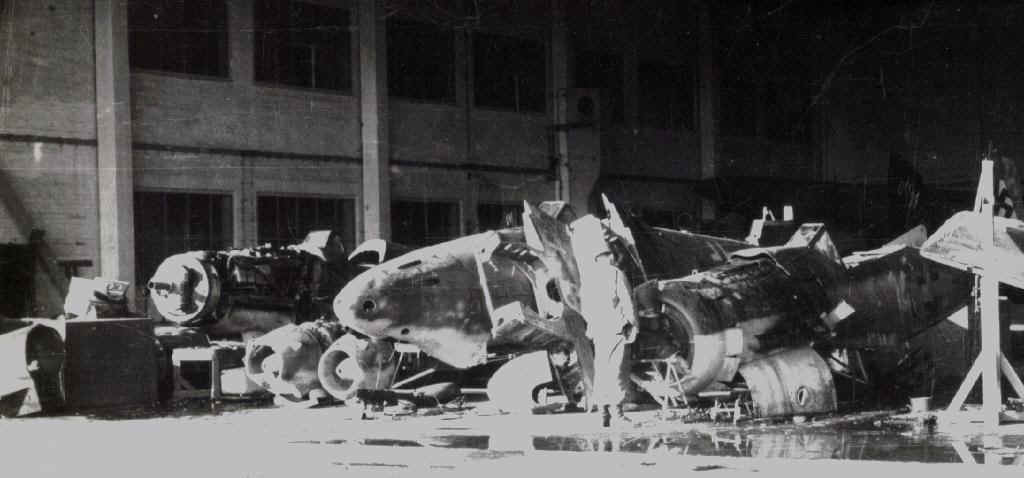
Image du Jours -- World War II
About this Hangar Scene -- WWII #9 of 23.

(Image from Stockum-Cashion Collection)
Not the most interesting of this series but a good one to start with since it shows the windowed area on the far left. This is where the camera was found that was used for this series of photos. I have not altered details in this image though the negative was pretty beat up. I will alter some but only in the case of tears or missing parts of the negative. In these cases, I have just filled in the missing area with the same detail that was around those areas.
Please, try to keep in mind my comments about these images because I will make an effort not to repeat too much. Soon you will have a good idea of the layout of this repair terminal without my drawing a map.
(When these images were originally posted, I had no idea of the actual location but now, more adept historians have agreed that the location must be Köthen, 80 miles SW of Berlin.)
The war was moving rapidly in this sector because there is little evidence of collateral damage -- not even strafing!
I do not think all of these aircraft were necessarily heaps of cannibalized airframes, though some appear to be in later photos.
From left-to-right is an Me-109G fuselage with prop blades removed as are the canopy and cowling; the cowling is sitting on the floor farthest to left. Seen between cowling and nose of aircraft is small test fixture with gauges on a sloping panel, possibly to test air and/or hydraulic pressure. The hollow prop shaft is really the barrel housing for a 20mm canon.
The Me-109G (Gustav) was the last 109 to see service in large numbers and while it lacked some of the nimbleness of the D, E, and F, it was a good fighter.
It was said that a Gustav could not best the P-51 in speed, the P-38 in altitude, the Spitfire in a turn, or match the P-47 in survivability, yet with a good pilot it could shoot down any of these aircraft because it was a worthy adversary. The Gustav was a strong, fast plane that was a superb compromise of all its opposition. The later, inexperienced Gustav pilots didn't know how to capitalize on its attributes.
When the Technical Office of the Luftwaffe was discussing with Willy Messerschmitt their on-going needs, the conversation became heated. Willy said that there was a limit to what "an intelligent person would expect from a fighter that first saw combat in 1937."
The Technical Office rep finally told Messerschmitt to come up with a fighter with speed, but also one with greater range and a higher rate of climb."
It was reliably reported that Messerschmitt angrily shouted, "What do you want? A fast fighter or a barn door?"
In Augsburg, two years later, these same two men were forced to run for shelter while P-47's skimmed low over the countryside. The P-47s were shooting anything that looked interesting. (The P-47 had eight, 50-caliber machine guns; each firing at 750 rounds a minute.)
At the sight of the powerful fighters strafing deep within the country, the official of the Technical Office turned to Messerschmitt with the acid reply:
"Well, there are your barn doors!"
There is no record of Messerschmitt's reply.
Over 30,000 Me-109s were built and each modification had made it more deadly. (When speaking of this aircraft, the "Me" indicates the designer. Just as correct is Bf-109, as this indicates the manufacturer.)
Beside the Me-109G in the photo is an engine from an Me-262 with lower nacelle damage -- not unlike it might receive with the failure of nose gear.
Next is another Me-262 engine. This engine is not attached to the adjacent fuselage.
Then, there is an Me-262 fuselage without canopy and vertical empennage. (Canopies were removed if any depot work was done -- but not the fin/rudder.)
Leaning against the fuselage is the central wing and double spar section for an Me-262.
Next to that is the fuselage of a Fw-190D; props have been broken and its spinner removed and it rests to left of the GI -- pretty much where someone would have turned around to lay it after removing it. The wing center section has been removed, as has the top cowling, which I do not see. The cowling by the nose is not the top, but the lower cowling.
The two fuselage guns are seen side-by-side still mounted to the aircraft. I am comfortable that this aircraft was in for repairs and it was expected it would return to service.
This Fw-190 with "14" on its side and spiral trim on its spinner might be assigned to a particular, identifiable group.
All three of these aircraft were on stands of some kind and they were supported to minimize damage.
In the shadows at the other side of the hangar is an He-111. (This is seen in detail only if the density of the image is lightened considerably.) From other views, it appears complete but since I see no props, it might not have had engines.
All in all, an interesting assortment of late-Luftwaffe arsenal.
I have (from these German aircraft types) an electric-directional gyro, turn-bank indicator from a Fw-190 (this one?), and a transmitter from an He-111 (that one?).
I also have a German flight computer dated "Nov. 1937" -- perhaps it was the one that was misunderstood on a fateful night flight between Germany and England -- when the RAF was saved and several thousand British citizens were condemned.
Serious stuff is this, but we can humor ourselves in fanciful remembrances of those days of heroes -- those days as they are presented to us by "just a GI" with a recently-found German camera.
Ken Cashion
******************************************